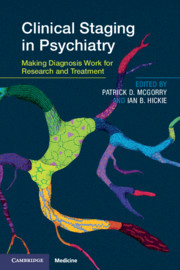Book contents
- Clinical Staging in Psychiatry
- Clinical Staging in Psychiatry
- Copyright page
- Contents
- Contributors
- Foreword
- Acknowledgements
- Section 1 Conceptual and Strategic Issues
- Section 2 Progress with Clinical Staging
- Chapter 5 The Utility of Clinical Staging in Youth Mental Health Settings
- Chapter 6 Neuroimaging and Staging
- Chapter 7 Staging of Cognition in Psychiatric Illness
- Chapter 8 Neuroinflammation and Staging
- Chapter 9 Bioactive and Inflammatory Markers in Emerging Psychotic Disorders
- Chapter 10 Electroencephalography and Staging
- Section 3 Novel Treatment Strategies
- Section 4 Novel Treatment Strategies
- Index
- Plate Section (PDF Only)
- References
Chapter 6 - Neuroimaging and Staging
Do Disparate Mental Illnesses Have Distinct Neurobiological Trajectories?
from Section 2 - Progress with Clinical Staging
Published online by Cambridge University Press: 08 August 2019
- Clinical Staging in Psychiatry
- Clinical Staging in Psychiatry
- Copyright page
- Contents
- Contributors
- Foreword
- Acknowledgements
- Section 1 Conceptual and Strategic Issues
- Section 2 Progress with Clinical Staging
- Chapter 5 The Utility of Clinical Staging in Youth Mental Health Settings
- Chapter 6 Neuroimaging and Staging
- Chapter 7 Staging of Cognition in Psychiatric Illness
- Chapter 8 Neuroinflammation and Staging
- Chapter 9 Bioactive and Inflammatory Markers in Emerging Psychotic Disorders
- Chapter 10 Electroencephalography and Staging
- Section 3 Novel Treatment Strategies
- Section 4 Novel Treatment Strategies
- Index
- Plate Section (PDF Only)
- References
Summary
Integration of brain structural information into prognostic and treatment formulation is key for achieving an all-encompassing biopsychosocial approach in psychiatry. Uncovering biological markers of specific mental illnesses, specific illness stages and of remission, may help further our understanding of the aetiology and precipitators of certain types of psychopathologies, identify central neurobiological processes as distinct from epiphenomena, validate boundaries of clinical groups, and potentially aid in predicting response to treatment. This book chapter reviewed the current structural neuroimaging evidence in three prominent mental illness domains: schizophrenia-spectrum, bipolar and depressive disorders. The large degree of overlap in abnormal neuropathology across the broad mental illness groups, which is no doubt partially due to within-group heterogeneity, makes the discovery of sets or networks of localized diagnosis-specific neural biomarkers unlikely. However, this is not to say that subtle distinctions in neural abnormalities do not exist, but rather challenges the usefulness of traditional diagnostic categories in the context of brain imaging being applied within a clinical staging model. A focus on identifying and characterising microscale circuits that are dysfunctional and which map onto symptomatology in a transdiagnostic manner, may have the greatest implications for clinical translation in the near future.
- Type
- Chapter
- Information
- Clinical Staging in PsychiatryMaking Diagnosis Work for Research and Treatment, pp. 103 - 139Publisher: Cambridge University PressPrint publication year: 2019
References
- 1
- Cited by



